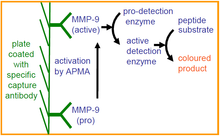Description
Quantify both endogenous active MMP-9 and total MMP-9
The QuickZyme Mouse MMP-9 Activity Assay enables you to specifically measure in biological samples both active mouse MMP-9, as well as (pro)MMP-9 which is activated on the plate by APMA. It can be used for the measurement of MMP-9 activity in various biological samples, such as conditioned culture media, tissue homogenates, serum, plasma and urine.
This 96-well plate format assay is based on the QuickZyme technology, using a modified pro-enzyme as a substrate, which upon activation is able to release color from a chromogenic peptide substrate. This multiplication step provides a unique assay sensitivity.
Features
- Measures both endogenous active MMP-9 (naturally occurring) and total active MMP-9 (following activation with APMA).
- Samples: cell culture conditioned medium, serum, plasma, urine and tissue homogenates.
- Quantitative.
- Range: 4 – 4000 pg/ml.
- Sensitivity: 20 pg/ml for 1 h incubation with detection reagent; 1 pg/ml for 6 h incubation with detection reagent.
- Ease-of-use: Equivalent to ELISA.
Type
Enzyme activity immunoassay

Applications
- cell culture conditioned medium, serum, plasma, urine, tissue homogenates
Sensitivity
- 20 pg/ml (1 hr incubation)
- 1 pg/ml (6 hr incubation)
Quantitative Measurement

The QuickZyme Mouse MMP-9 Activity Assay is a quantitative replacement for qualitative zymography.
Storage
Unopened kit: Store at -20°C, except for the standard, this vial should be stored at -70°C. Do not use kit, or individual kit components past kit expiration date.
Opened kit / reconstituted reagents: Please refer to kit manual.
Other names
Matrix metalloproteinase-9, MMP9, 92 kDa gelatinase, 92 kDa type IV collagenase, Gelatinase B, GELB
Resources
Product References
- Ashida, Shinichi et al. “Administration of anti-inflammatory M2 macrophages suppresses progression of angiotensin II-induced aortic aneurysm in mice.” Scientific reports vol. 13,1 1380. 25 Jan. 2023, doi:10.1038/s41598-023-27412-x
- Nakashima, Ryunosuke et al. “Metformin suppresses epithelial sodium channel hyperactivation and its associated phenotypes in a mouse model of obstructive lung diseases.” Journal of pharmacological sciences vol. 149,2 (2022): 37-45. doi:10.1016/j.jphs.2022.03.002
- Fujimoto, Yuki et al. “Dual therapy with zinc acetate and rifaximin prevents from ethanol-induced liver fibrosis by maintaining intestinal barrier integrity.” World journal of gastroenterology vol. 27,48 (2021): 8323-8342. doi:10.3748/wjg.v27.i48.8323
- Kuramoto, Toru et al. “Chymase as a Novel Therapeutic Target in Acute Pancreatitis.” International journal of molecular sciences vol. 22,22 12313. 15 Nov. 2021, doi:10.3390/ijms222212313
- Nikolakopoulou, Angeliki Maria et al. “Endothelial LRP1 protects against neurodegeneration by blocking cyclophilin A.” The Journal of experimental medicine vol. 218,4 (2021): e20202207. doi:10.1084/jem.20202207
- Shiraishi, Yasuyuki et al. “Short-term inhibition of fibrinolytic system restores locomotor function after spinal cord injury in mice.” Scientific reports vol. 9,1 16024. 5 Nov. 2019, doi:10.1038/s41598-019-52621-8
- Takezaki, Akio et al. “A homozygous SFTPA1 mutation drives necroptosis of type II alveolar epithelial cells in patients with idiopathic pulmonary fibrosis.” The Journal of experimental medicine vol. 216,12 (2019): 2724-2735. doi:10.1084/jem.20182351
- Kawai, Yohei et al. “Montelukast, a Cysteinyl Leukotriene Receptor 1 Antagonist, Induces M2 Macrophage Polarization and Inhibits Murine Aortic Aneurysm Formation.” BioMed research international vol. 2019 9104680. 27 May. 2019, doi:10.1155/2019/9104680
- Andersson, Patrik et al. “Molecular mechanisms of IL-33-mediated stromal interactions in cancer metastasis.” JCI insight vol. 3,20 e122375. 18 Oct. 2018, doi:10.1172/jci.insight.122375
- Seifert, Robert et al. “Molecular imaging of MMP activity discriminates unstable from stable plaque phenotypes in shear-stress induced murine atherosclerosis.” PloS one vol. 13,10 e0204305. 10 Oct. 2018, doi:10.1371/journal.pone.0204305
- Orner, Caitlin A et al. “Low-Dose and Short-Duration Matrix Metalloproteinase 9 Inhibition Does Not Affect Adhesion Formation during Murine Flexor Tendon Healing.” Plastic and reconstructive surgery vol. 137,3 (2016): 545e-553e. doi:10.1097/01.prs.0000475823.01907.53
Related Products
Ilex Life Sciences LLC is an official distributor of QuickZyme Biosciences.




